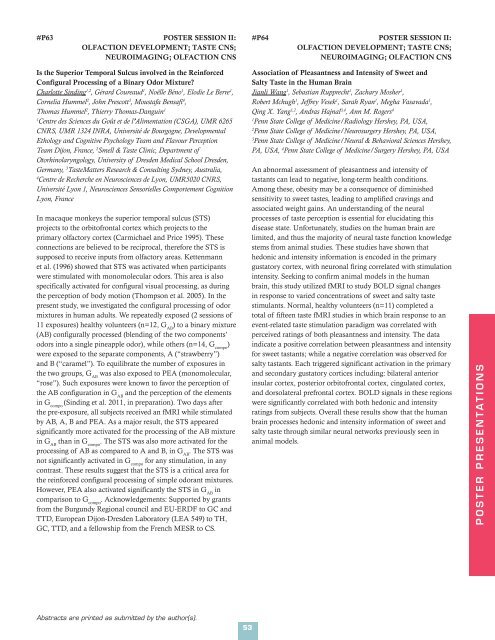Abstracts - Association for Chemoreception Sciences
Abstracts - Association for Chemoreception Sciences
Abstracts - Association for Chemoreception Sciences
You also want an ePaper? Increase the reach of your titles
YUMPU automatically turns print PDFs into web optimized ePapers that Google loves.
#P63 POSTER SESSION II:<br />
OLFACTION DEVELOPMENT; TASTE CNS;<br />
NEUROIMAGING; OLFACTION CNS<br />
#P64 POSTER SESSION II:<br />
OLFACTION DEVELOPMENT; TASTE CNS;<br />
NEUROIMAGING; OLFACTION CNS<br />
Is the Superior Temporal Sulcus involved in the Rein<strong>for</strong>ced<br />
Configural Processing of a Binary Odor Mixture?<br />
Charlotte Sinding 1,2 , Gérard Coureaud 1 , Noëlle Béno 1 , Elodie Le Berre 1 ,<br />
Cornelia Hummel 2 , John Prescott 3 , Moustafa Bensafi 4 ,<br />
Thomas Hummel 2 , Thierry Thomas-Danguin 1<br />
1<br />
Centre des <strong>Sciences</strong> du Goût et de l’Alimentation (CSGA), UMR 6265<br />
CNRS, UMR 1324 INRA, Université de Bourgogne, Developmental<br />
Ethology and Cognitive Psychology Team and Flavour Perception<br />
Team Dijon, France, 2 Smell & Taste Clinic, Department of<br />
Otorhinolaryngology, University of Dresden Medical School Dresden,<br />
Germany, 3 TasteMatters Research & Consulting Sydney, Australia,<br />
4<br />
Centre de Recherche en Neurosciences de Lyon, UMR5020 CNRS,<br />
Université Lyon 1, Neurosciences Sensorielles Comportement Cognition<br />
Lyon, France<br />
In macaque monkeys the superior temporal sulcus (STS)<br />
projects to the orbitofrontal cortex which projects to the<br />
primary olfactory cortex (Carmichael and Price 1995). These<br />
connections are believed to be reciprocal, there<strong>for</strong>e the STS is<br />
supposed to receive inputs from olfactory areas. Kettenmann<br />
et al. (1996) showed that STS was activated when participants<br />
were stimulated with monomolecular odors. This area is also<br />
specifically activated <strong>for</strong> configural visual processing, as during<br />
the perception of body motion (Thompson et al. 2005). In the<br />
present study, we investigated the configural processing of odor<br />
mixtures in human adults. We repeatedly exposed (2 sessions of<br />
11 exposures) healthy volunteers (n=12, G AB<br />
) to a binary mixture<br />
(AB) configurally processed (blending of the two components’<br />
odors into a single pineapple odor), while others (n=14, G compo<br />
)<br />
were exposed to the separate components, A (“strawberry”)<br />
and B (“caramel”). To equilibrate the number of exposures in<br />
the two groups, G AB<br />
was also exposed to PEA (monomolecular,<br />
“rose”). Such exposures were known to favor the perception of<br />
the AB configuration in G AB<br />
and the perception of the elements<br />
in G compo<br />
(Sinding et al. 2011, in preparation). Two days after<br />
the pre-exposure, all subjects received an fMRI while stimulated<br />
by AB, A, B and PEA. As a major result, the STS appeared<br />
significantly more activated <strong>for</strong> the processing of the AB mixture<br />
in G AB<br />
than in G compo<br />
. The STS was also more activated <strong>for</strong> the<br />
processing of AB as compared to A and B, in G AB<br />
. The STS was<br />
not significantly activated in G compo<br />
<strong>for</strong> any stimulation, in any<br />
contrast. These results suggest that the STS is a critical area <strong>for</strong><br />
the rein<strong>for</strong>ced configural processing of simple odorant mixtures.<br />
However, PEA also activated significantly the STS in G AB<br />
in<br />
comparison to G compo<br />
. Acknowledgements: Supported by grants<br />
from the Burgundy Regional council and EU-ERDF to GC and<br />
TTD, European Dijon-Dresden Laboratory (LEA 549) to TH,<br />
GC, TTD, and a fellowship from the French MESR to CS.<br />
<strong>Association</strong> of Pleasantness and Intensity of Sweet and<br />
Salty Taste in the Human Brain<br />
Jianli Wang 1 , Sebastian Rupprecht 1 , Zachary Mosher 1 ,<br />
Robert Mchugh 1 , Jeffrey Vesek 1 , Sarah Ryan 1 , Megha Vasavada 1 ,<br />
Qing X. Yang 1,2 , Andras Hajnal 3,4 , Ann M. Rogers 4<br />
1<br />
Penn State College of Medicine/Radiology Hershey, PA, USA,<br />
2<br />
Penn State College of Medicine/Neurosurgery Hershey, PA, USA,<br />
3<br />
Penn State College of Medicine/Neural & Behavioral <strong>Sciences</strong> Hershey,<br />
PA, USA, 4 Penn State College of Medicine/Surgery Hershey, PA, USA<br />
An abnormal assessment of pleasantness and intensity of<br />
tastants can lead to negative, long-term health conditions.<br />
Among these, obesity may be a consequence of diminished<br />
sensitivity to sweet tastes, leading to amplified cravings and<br />
associated weight gains. An understanding of the neural<br />
processes of taste perception is essential <strong>for</strong> elucidating this<br />
disease state. Un<strong>for</strong>tunately, studies on the human brain are<br />
limited, and thus the majority of neural taste function knowledge<br />
stems from animal studies. These studies have shown that<br />
hedonic and intensity in<strong>for</strong>mation is encoded in the primary<br />
gustatory cortex, with neuronal firing correlated with stimulation<br />
intensity. Seeking to confirm animal models in the human<br />
brain, this study utilized fMRI to study BOLD signal changes<br />
in response to varied concentrations of sweet and salty taste<br />
stimulants. Normal, healthy volunteers (n=11) completed a<br />
total of fifteen taste fMRI studies in which brain response to an<br />
event-related taste stimulation paradigm was correlated with<br />
perceived ratings of both pleasantness and intensity. The data<br />
indicate a positive correlation between pleasantness and intensity<br />
<strong>for</strong> sweet tastants; while a negative correlation was observed <strong>for</strong><br />
salty tastants. Each triggered significant activation in the primary<br />
and secondary gustatory cortices including: bilateral anterior<br />
insular cortex, posterior orbitofrontal cortex, cingulated cortex,<br />
and dorsolateral prefrontal cortex. BOLD signals in these regions<br />
were significantly correlated with both hedonic and intensity<br />
ratings from subjects. Overall these results show that the human<br />
brain processes hedonic and intensity in<strong>for</strong>mation of sweet and<br />
salty taste through similar neural networks previously seen in<br />
animal models.<br />
POSTER PRESENTATIONS<br />
<strong>Abstracts</strong> are printed as submitted by the author(s).<br />
53
















